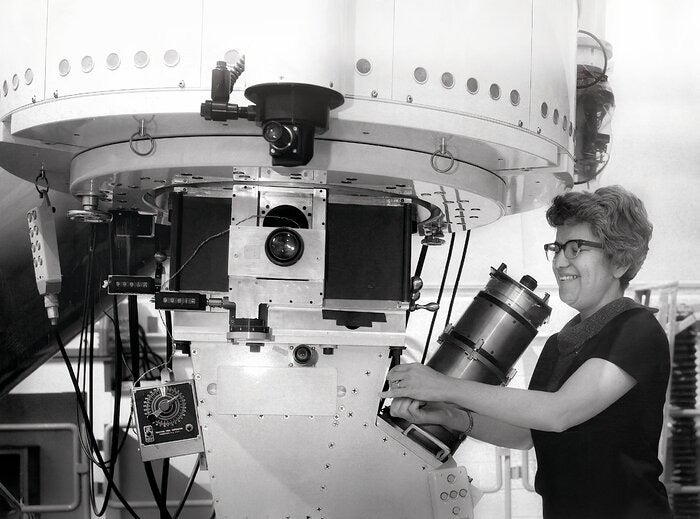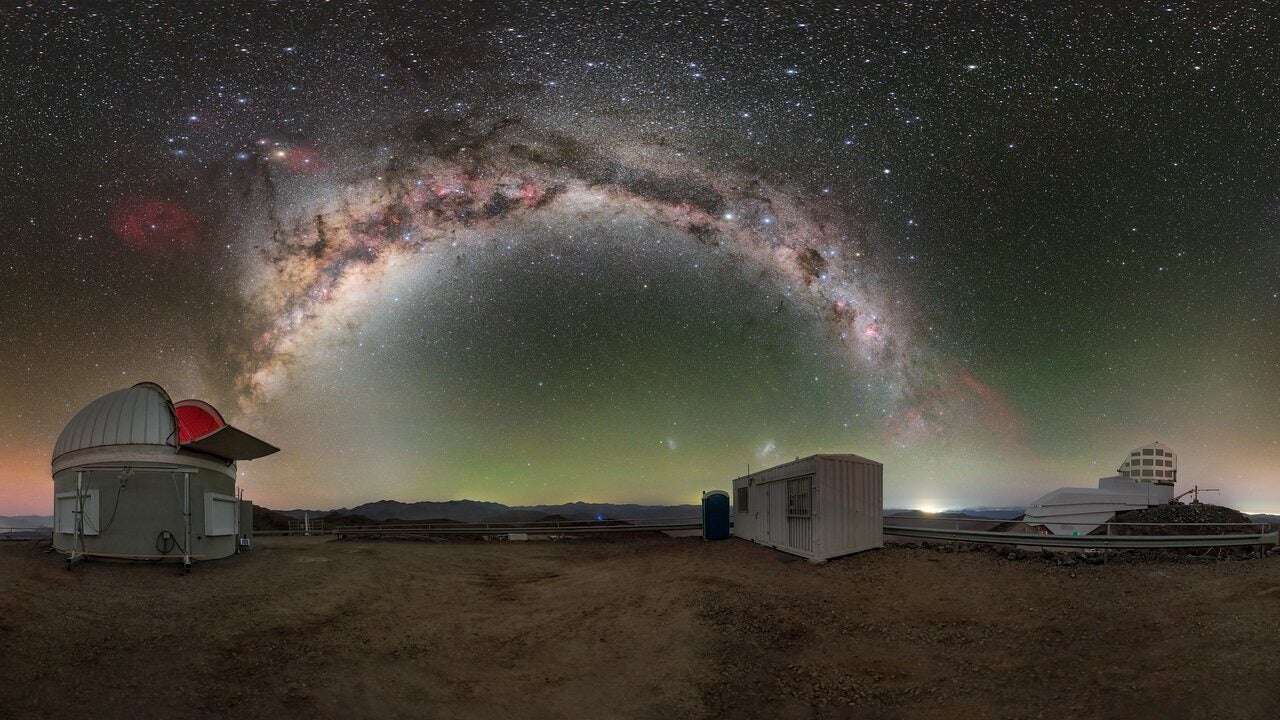
A century ago galaxies in our universe perplexed astronomers. Just a decade after the realization of what galaxies are, astronomers first noticed that spiral galaxies were rotating strangely. Their outer areas were rotating around the galactic centers nearly as quickly as their inner “hubs.” Something must have been helping the rotation along. In 1933, astronomer Fritz Zwicky first suggested that an unseen component, which he called dark matter, must exist.
Three decades after dark matter was hypothesized, in a breakthrough moment, one astronomer collected the first direct evidence of dark matter’s existence. Her name was Vera Rubin, and her work helped to revolutionize astronomy in the middle part of the 20th Century.
Rubin was born Vera Florence Cooper in Philadelphia on July 23, 1928 and died on Dec. 25, 2016. In her long and illustrious career, Rubin was a fierce advocate for women in science and a beloved colleague. Despite facing sexism and skepticism from the scientific community, she opened the doors for many women who followed.
From a young age, Rubin gazed outside her bedroom window in Washington D.C. and charted the paths of stars. With the support of her father, she even built a telescope out of cardboard and a small lens. Rubin’s father encouraged her curiosity and would take her to D.C. Amateur Astronomer Club Meetings, where she would hear about the latest ideas. “By about age 12, I would prefer to stay up and watch the stars than go to sleep. I started learning. I started going to the library and reading. But it was initially just watching the stars from my bedroom that I really did. There was just nothing as interesting in my life as watching the stars every night,” Rubin said in an interview with Alan Lightman for the American Institute of Physics in 1989
Education and sexism

Rubin’s captivation with the movement of objects in a dark night sky continued throughout her career. Inspired by Maria Mitchell, the first woman to become a professional astronomer in the United States, Rubin enrolled in Vassar College’s astronomy program after receiving a scholarship. There, she received her degree in 1948 as the sole astronomy major. While at Vassar, Rubin also worked during summers at the Naval Research Laboratory. Right after graduation, she married Robert Rubin, a physicist and naval officer on his way to completing a doctoral degree at Cornell University.
Despite being accepted to Harvard, Rubin joined her husband at Cornell University, where she earned her master’s degree in astronomy and studied under Philip Morrison, Richard Feynman, and Hans Bethe.
For Rubin’s master’s thesis, she investigated whether groups of galaxies moved like other objects in the universe, like the objects in the solar system orbiting the Sun. Later, the movement Rubin observed would be known as the supergalactic plane. Although the paper about this find was never published and was rejected by editors of the Astrophysical Journal and the Astronomical Journal, Rubin did present the results at the 1950 American Astronomical Society (AAS) Meeting.
After completing her master’s thesis, Rubin was called in by William Shaw, her thesis advisor, who offered to present Rubin’s findings under his name. At this time, Rubin was pregnant and not a member of the AAS. “Immediately, I replied, ‘No. I can go.’ We had no car. My parents drove from Washington D.C. to Ithaca, then crossed the snowy New York hills with Bob, me, and their first grandchild, ‘thereby aging 20 years,’ my father later insisted,” Rubin wrote in her autobiography. Just 22 at the time, Rubin delivered the talk three weeks after giving birth.
Her presentation was met with some skepticism. Martin Schwarzschild, an astronomer from Princeton, was the only one in the audience to offer support and told her she needed to collect more data to draw worthwhile conclusions.
Soon, Rubin graduated and became a full-time mother. But she could not keep away from astronomy. While taking her young child to the park, Rubin would read The Astrophysical Journal. There, she realized she missed research and, encouraged by her husband, decided to pursue a Ph.D. at Georgetown University. Rubin completed her degree in 1954 under physicist George Gamow. “Women generally required more luck and perseverance than men did. It helped to have supportive parents and a supportive husband,” she wrote in her autobiography.
Rubin’s dissertation demonstrated that galaxies are not neatly organized throughout the universe. Instead, they often cluster together. Rubin’s findings were confirmed fifteen years after her dissertation.
Rotation curves
Rubin taught at Georgetown University for a decade while raising four children and conducting research. In 1962, she published her first paper on flat rotation curves in the Astronomical Journal along with six of her graduate students. Though not well received then, the paper was referenced for a long time afterward. In this study, Rubin and her students found that the Milky Way’s rotational speed was flat and did not decrease as expected.
“They didn’t get a dip. They got this weird flattening. And that flattening meant that there’s more mass at the edge than we would have expected. There’s this disconnect between the masses we see, which is the stars, the gas, things like that. And the mass that is clearly exerting some sort of gravitational influence. So that classwork kicked off this idea,” says Emily Levesque, an astrophysicist at the University of Washington.
A new tool to observe the skies
In 1965, Rubin met Kent Ford at the Carnegie Institution of Washington’s Department of Terrestrial Magnetism (DMT). At the time, Ford developed an improved spectrograph that could be used to study galaxy rotation curves. Rubin began by examining quasars along with Ford but then decided to focus on the rotation of the Andromeda Galaxy (M31). “I decided to pick a problem that I could go observing and make headway on, hopefully, a problem that people would be interested in, but not so interested [in] that anyone would bother me before I was done,” Rubin told Lightman.
Rubin’s focus on galaxy rotational curves led to the first direct evidence of dark matter. With Ford’s spectrograph, Rubin employed some of the world’s most powerful telescopes, and became the first woman to observe with the 5-m telescope at Palomar Mountain Observatory. As Rubin and Ford observed more and more galaxies, they found more and more evidence for the flat rotation curves. In 1970, the team published their paper on the rotation curve of the Andromeda Galaxy in the Astrophysical Journal.
“They kept seeing flat curves, and it eventually turned into this clear evidence that in a spinning galaxy, there is matter that we can’t see,” says Levesque. “There’s matter that is clearly behaving gravitationally like other matter, but it’s not interacting with light at all.” Researchers infer the existence of dark matter due to the effects it has on observable matter.
Rubin’s team provided the most complete and concrete evidence with a large amount of data. “Those rotation curves where you’re plotting the distance of the galaxy against its velocity were very, very clear, says Ashley Yeager, Associate News Editor at Science News and author of Bright Galaxies, Dark Matter, and Beyond: The Life of Astronomer Vera Rubin. “And you’re taking measurements in the type of light that our eyes see, and so I think the community which was comfortable with optical astronomy had been around for centuries.”
Vera Rubin’s impact
Rubin was a fierce advocate for women in science throughout her career. Having faced much skepticism and pushback, Rubin worked to open doors for other female astronomers. At the Carnegie Institution, Rubin spoke to and encouraged many young women in science and invited young post-docs to work with her at the DMT. “She also made sure that at any big conferences, they would invite many women speakers, and if not, she would contact the organizers,” says Neta Bahcall, a cosmologist at Princeton University and one of Rubin’s close friends. Throughout her career, Rubin also wrote about and championed other women scientists such as Charlotte Moore Sitterly.
“The other thing that always comes up when talking about Vera is how many people she mentored along the way,” says Yeager. “And I don’t mean that in a light sense. I mean, she really helped shape a lot of women’s careers and a lot of other scientist’s careers and probably beyond scientists. I mean, I consider she also shaped my career.”
What awards did Vera Rubin receive?
In her lifetime, Rubin received more than a dozen awards and honors. To name a few, Vera Rubin was elected to the National Academy of Sciences, received the National Medal of Science in 1993, and in 1996 was awarded the Gold Medal of the Royal Astronomical Society, the first woman to do so since Carolyn Herschel in 1828. Rubin was never awarded the Nobel Prize. “She has won every scientific award that a scientist can win except the Nobel Prize, says Levesque, “and at this point, it’s seemed more like a glaring omission on the Nobel Prize committee’s part.” Rubin authored greater than 200 scientific papers on galaxies.
Vera Rubin’s legacy

Rubin dedicated her career to studying the movement of stars and understanding galaxies. In the second half of 2024, when the Vera C. Rubin Observatory is complete, the telescope will host an 8.4-meter instrument, a sophisticated data processing system, and a 3200-megapixel camera that will continuously capture images of the sky. Prior to 2019, the observatory was called the Large Synoptic Survey Telescope. The telescope is currently undergoing construction at Cerro Pachón, Chile.
When the instrument sees first light, it will capture data from the stars and galaxies that Rubin adored. “My life has been an interesting voyage,” she once said. “I became an astronomer because I could not imagine living on Earth and not trying to understand how the universe works.”









